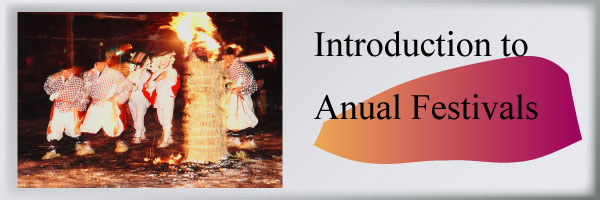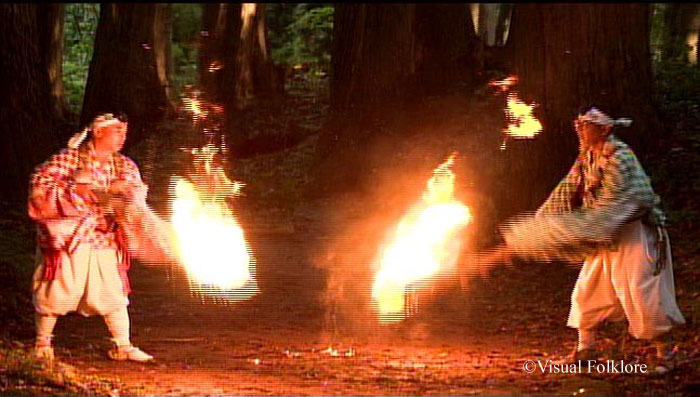Cradle [クレードル] 出羽庄内地域文化情報誌
The cultural informational magazine which visits the charm of Shonai.

◆January 1st◆ Saitan Festival Sanshin-Gosaidan, Mt. Haguro
◆May 8th ◆ Toshigoi Festival Rice planting festival; Sanshin-Gosaidan, Mt. Haguro
The Toshigoi Festival is a prayer service for a good crop. The “toshi” refers to grains, particularly the rice plant. This festival is held before farming work is carried out in the spring to pray for an abundant harvest.
The ritual “tamai” music and dancing was passed on from husband and wife court musicians named Tomita Kasuga Grand Shrine in Nara in 1877. The Shinto priest likens the altar to a field and presents a series of performances before rice planting that includes the sickle rite, the hoe rite, the rake rite, and the planting rite.
The Shinto priest and shrine maidens dance to songs about “unripe seeds,” “sowing foxtail millet,” “rice flour dumplings” and “fukumangoku (wealth)” to represent the growth of rice plants and millet, raising crops safe from storms, and rich rice harvests throughout Japan.
◆June 1st ◆ Kaisan Festival, Yudonosan Shrine Main Shrine, Yudonosan Shrine
Mt. Yudono, regarded as the most sacred shrine because it stands nestled behind the others, is closed during the winter because it is covered in snow. The shrine can be worshipped from around April 29th to November 3rd. This festival to celebrate the shrine’s opening is held on June 1st.
The year 2005 marked 1400 years since its opening. To commemorate, a footbath of sacred water was created within the main shrine, and a sacred bath at Nibu Kosen (mineral springs) was established within the sanrojo (where priests can retire alone to pray) at Senninzawa.
◆July 1st ◆ Kaisan Festival, Gassan Shrine Main Shrine, Gassan Shrine
Mt. Gassan, the highest of the Dewa Sanzan mountains, is closed from September 15th when autumn colors begin until July 1st when it becomes suitable for summer mountaineering. The Kaisan Festival prays for the safety of the climbers and the repose of the souls of the ancestral spirits. Around this time, the alpine flora all bloom at once, seemingly celebrating the short summer.
◆July 15th ◆ Reitai Festival (Flower Festival) Sanshin-Gosaidan, Mt. Haguro
This festival takes place during the flowering season of the rice plants to pray for bountiful harvests and safety from disasters, including offering prayers for the well-being of family. Portable shrines from the three mountains are carried around Mitarashi-ike (Mirror Pond), and long staffs decorated with handmade flowers to represent the flowering rice plants are included in the procession of portable shrines. Because it is said that those who get hold of a flower are highly favored by the gods and given the best crops, the worshippers who fill the shrine grounds scramble to get the flowers as the festival reaches its climax.
◆August 13th◆ Saito Festival, Gassan Shrine Main Shrine, Gassan Shrine
◆August 14th◆ Hongu Festival, Gassan Shrine Main Shrine, Gassan Shrine
◆August 15th◆ Hongu Festival, Yudonosan Shrine Main Shrine, Yudonosan Shrine
◆August 26th–September 1st◆ Aki-no-mine
Dewa Sanzan was established in 593 by Prince Hachiko, the son of Emperor Shushun (the 32nd emperor). The ancient practice of Haguro Shugendo tells us even today of the ascetic life lived by the prince until the mountains were opened. The largest ascetic practice is the Aki-no-mine.
◆August 31st◆ Hachiko Shrine Festival Hassaku Festival
◆September 1st◆ Denmen Festival
The word “hassaku” refers to the date, August 1st. This is the fruiting period for rice plants, and the festival offers prayers to keep crops that are reaching maturity safe from disaster. At 10PM on August 31st as the annual festival is held at Hachiko Shrine, after the Aki-no-mine ascetic practitioners report their training to Prince Hachiko, they set fire to brushwood stacked on the gomadan fire altar in front of the shrine. This is to honor the spirits of the dead with saitogoma fire and worship the gods through the flames. Next, the activities move to the Sanshin-Gosaidan where at midnight the Denmen Festival is held. Since this takes place during the fruiting period for the rice plants, prayers are made for safety from disaster brought on by typhoon.
◆September 6th–10th ◆ Miko Ascetic Practices
This was created in 1993, the year that marked 1400 years since Dewa Sanzan was opened, to allow women to undergo the ascetic practices. It is one of the most important events at Dewa Sanzan Shrine. For 3 nights and 4 days at Fukikoshikomori Hall on Mt. Haguro, women undergo harsh training that includes a purification ceremony, religious services, and climbing mountains.
◆October 15th◆ Sukeikosha Festival, Dewa Sanzan Shrine
◆October 24th◆ Tenyu Festival
◆November 23rd◆ Shin Festival
◆December 31st◆ Shorei Festival
This festival is held through the night every year from New Year’s Eve until the early light of New Year’s Day, earning it the name “Toshiya Festival.” This ritual completes the vows made for Fuyu-no-mine, one of the ascetic practices conducted during the 4 seasons of Haguro Shugendo.
Two virtuous “matsunohijiri” monks, the “ijo” and the “sendo,” are chosen from shrine parishioners living in the temple town of Toge to engage in ascetic practices for 100 days from September 24th. During that time, an altar is prepared and prayers are made to spirits represented by grains contained in a small thatched hut. Prayers are also made for an abundant harvest and peace. In addition, the priests solicit funds for this ancient ritual from the homes of those living in the Shonai Region.
On December 30th, local youth ascend the mountain and divide into the “ijo” group and the “sendo” group. A ritual called Otaimatsu Maruki takes place where 2 huge torches resembling harvest mites and representing evil are created. This ritual is based on the story about the founder of the shrine, Prince Hachiko, who could not bear to see the sad state of the people suffering from an infestation of harvest mites and built a large fire to successfully ward off the pests. Thereafter, all events have taken the form of a competition between the superiority/progress of the “ijo” group and the “sendo” group.
Centering on the two chosen yamabushi priests who underwent the 100 days of harsh training, the New Year is greeted with a variety of rituals such as genkurabe (a test of powers of religious endurance), Otaimatsu-hiki (torch pulling), a kokubun ] ritual, and a new fire ceremony. The thick rope decorating the homes of people in Toge, Haguro were used in this festival and are talismans said to keep away disaster and bring good fortun.
Cradle[クレードル]出羽庄内地域文化情報誌
"Cradle secretariat" telephone: 0800-800-0806 or E-Mail
